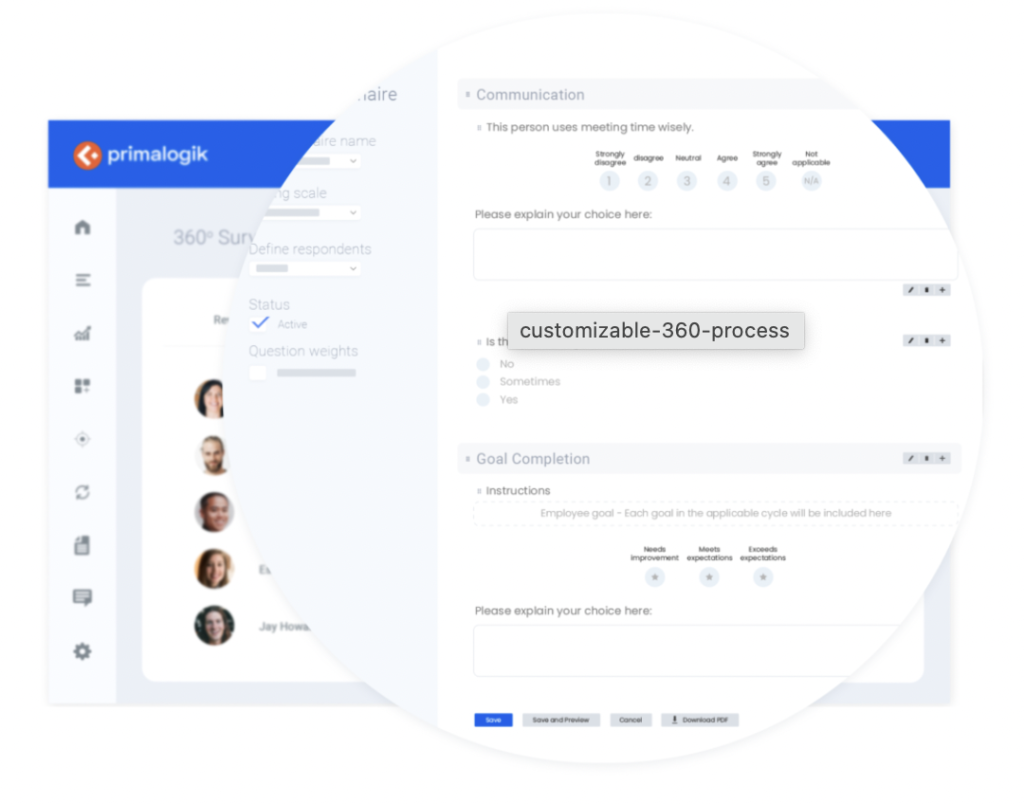Interested in conducting 360 reviews but not sure where to begin? The 360 review is a great tool for gaining feedback about employee performance. With this input, you can more effectively guide employees to success. Everyone from entry-level employees to senior leaders will benefit. However, you need to thoroughly understand the purpose and process first.
Read on to learn about the 360 review process and how to get it right.
Navigation
2. Pros and Cons of A 360 Review
3. What Makes for A Successful 360 Review?
4. Sample Questions for A 360 Review
5. Make 360 Reviews an Ongoing Part of Performance Improvement
What Is A 360 Review?
A 360 review collects detailed feedback on an employee’s performance. The purpose is to help employees (and managers) learn where they need to improve. To do this, it surveys a broad range of people, such as:
- Peers on their team
- Leaders
- Direct reports
- Clients
- Colleagues in other departments
Each of these people has a valuable perspective to share. (Peer feedback can boost performance by 14%, Gartner has found.) And no one—including the employee’s supervisor—has the whole picture. The 360 review synthesizes this range of perspectives to gain rich insights.
Employees then benefit from a well-rounded understanding of their strengths and weaknesses. Again, the purpose is to help them grow professionally. The review should have no bearing on promotional and salary-related decisions. That would be a sure way to breed resentment between employees!
Plus, it would be unfair. “It creates less defensiveness if people have a chance to work on their skill gaps before they are evaluated on them,” says the Society for Human Resource Management (SHRM).
In most cases, reviewers remain anonymous. This encourages people to voice feedback candidly.
Pros and Cons of A 360 Review
We’ll first take a look at the key benefits of 360 feedback. Then, we’ll dive into major pitfalls to avoid.
Pros:
- It expands employees’ self-awareness. In particular, it helps them strengthen interpersonal skills. They learn how to overcome issues that may undermine communication and collaboration.
- It can give hybrid or remote employees much-needed feedback. It’s important to make an extra effort to give these employees input. This feedback can greatly improve team cohesiveness.
- It can help reduce bias based on gender, age, race, and other characteristics. If the employee’s manager holds unconscious bias, the review can provide a more accurate perspective.
- It substantially improves the chances that employees will make the desired changes. Input from just one person is easy to discount. The employee might think, “Oh, it’s just her opinion.” But in a 360 review, themes appear. Patterns emerge. And as a result, employees become more receptive to feedback.
Cons:
- Reviewers can succumb to proximity bias. This means noticing the contributions of people they work with most closely. In a hybrid workforce, it can mean more favourable reviews for in-office employees.
- It can involve a lot of time and expense. Traditionally, a 360 review can involve hiring an outside consultant. Or, it can require HR to devote an enormous amount of time to the process. Fortunately, software solutions overcome this challenge!
- Employees can be overly favourable toward coworkers they have closer relationships with. Or, they might avoid criticism for fear it will harm the other person.
What’s the solution to these issues? First, communicate the purpose of the review. People will then be less likely to give coworkers overly positive reviews. After all, the reviews are conducted for each employee’s benefit! Second, train all reviewers on how to avoid bias. And review their reviews as they come in.
Speak with reviewers before sharing the feedback if you suspect bias exists. Ask them for clarification if they gave any vague answers. And choose a 360 review tool that cuts down the time and cost factor exponentially.
What Makes for A Successful 360 Review?

Using 360 reviews improperly can have harmful consequences. For instance, it can provide an unclear picture of strengths and weaknesses. We’ll review best practices for a successful review. Then, we’ll present a list of suggested questions to ask.
How to Administer a 360 Review
Follow these tips to gain valuable info that guides employees’ growth.
Invest in a Quality Tool
Choosing a good 360 feedback tool will ensure you get the best results. It helps you follow a standardized process to gain accurate, bias-free info. It generates questions that solicit detailed input. And it presents results in an easy-to-understand format. For instance, it might share graphs illustrating progress in certain areas. Further, it can even point out patterns of bias.
Start at the Top Ranks
Begin at the top, says David Epstein, U.S. HR director for Doctors Without Borders. Conduct 360 reviews with organizational leaders first. This will increase buy-in among all employees. It also helps leaders understand the process and the value of the data.
“Leaders should understand the process, and ideally, go through it themselves so that they can relay a positive experience to other employees,” Epstein explains in Forbes. “In my organization, we started a 360-degree feedback program with the chair of the board, then piloted the program for the senior management team.”
Define What You’re Measuring
Define the core competencies needed to succeed, says Epstein. Those are the skills you’ll measure in your 360 review. They’ll vary depending on job rank and position. For example, coaching ability is crucial in a leader.
Focus on Behaviours
Prompt reviewers to give specific feedback. They should focus on behaviours that they’ve observed. Use “behavioural language” in your questions. For example, don’t ask, “Do clients appreciate the employee’s work?” Ask questions like, “Does the employee follow up with clients about their satisfaction?”
This leads to more objective answers. In contrast, questions that don’t focus on behaviours are open to interpretation. This makes answers more subjective—and less useful in a 360 review.
Choose Reviewers Carefully
Be careful not to only select people who have a close relationship with the employee. The employee might work with HR to choose reviewers. (HR can ascertain whether the employee’s suggestions are appropriate.) Getting at least 12 reviews is ideal, depending on organizational size. Employees can also complete a self-evaluation.
This lends insights into their level of self-awareness.
Provide Clear Guidelines
All reviewers need to follow the same guidelines for answering the questions. For questions that use a rating scale (e.g., 1–5 or 1–10), they must know how the scale works. Clearly outline the criteria for each number and explain it to them.
Discuss the Results
Discuss the findings with the employee. Don’t just email a report and consider the process complete. Employees need help interpreting the findings. More importantly, they need to figure out where to go from there. Help them understand how to develop the areas in question.
HR can share the results directly with the employee. This emphasizes that the results aren’t coming just from the supervisor. Also, it puts control of the process in the employee’s hands. The employee should then reach out to the supervisor to create a plan.
Follow Up
Provide follow-up support. Employees may need tools, training, or mentorship to grow. Continue to evaluate whether they have the appropriate learning resources. And talk with them regularly over the coming months about their progress.
HR should handle many of these steps. It must decide on a cohesive process for the whole organization to follow. HR should also give supervisors guidance on how to discuss the results and follow up.
Sample Questions for A 360 Review

We’ve grouped sample questions into several key areas. Each of these questions deals with behaviours. They are presented in a multiple-choice format.
1 = Strongly disagree, 2 = Disagree, 3 = Neither agree nor disagree, 4 = Agree, 5 = Strongly agree
Communication
Does the employee…
- Ask questions when confused?
- Listen actively when others speak?
- Present ideas in an easily understandable way?
Collaboration
Does the employee…
- Share updates on important tasks with the team?
- Convey enthusiasm for group projects?
- Participate in group discussion?
- Proactively work to solve problems?
Emotional intelligence
Does the employee…
- Stay calm under pressure?
- Check in with others about their needs?
- Speak to others in a supportive manner?
- Welcome constructive feedback?
Time-management
Does the employee…
- Set clear priorities?
- Overpromise how quickly tasks can be completed?
- Complete tasks efficiently?
You can also use questions in a statement format. Here are a few examples:
1 = Strongly disagree, 2 = Disagree, 3 = Neither agree nor disagree, 4 = Agree, 5 = Strongly agree
- Employee effectively mentors others.
- John is productive when working independently.
- Sarah strives to build a positive relationship with every team member.
Again, note how these questions prioritize behaviours. “Employee is productive when working independently” is more behaviour-focused than “Employee is self-motivated.”
Finally, you can ask open-ended questions. For instance, “If you had to choose one thing for the employee to improve, what would it be?” Questions like this ensure the employee will receive constructive criticism. If reviewers are being too “nice,” it prompts more candid feedback.
The questions you choose will depend on the core competencies for the role. Questions for a leader will cover topics like mentoring ability and strategic thinking, for instance. SHRM provides a form with questions on a variety of leadership behaviours. For example:
- “Translates the corporate vision into actionable plans.”
- “Allows for flexibility in how work is accomplished.”
- “Sets clear performance expectations in advance.”
Make sure your 360 survey doesn’t grow too lengthy. Keep it on the short side so people can complete it in around 15 minutes. This will encourage all reviewers to respond in a timely manner.
Make 360 Reviews an Ongoing Part of Performance Improvement

Following the best practices outlined here will deliver invaluable insights. Each employee will flourish as they receive accurate input about their performance. Providing ongoing guidance will ensure they make good use of it.
For best results, conduct 360 reviews periodically so you can observe progress. Many companies gather 360 feedback every 3 to 6 months. This also gives employees the satisfaction of seeing how they improve.
Ready to launch 360 reviews with your workforce? Request a demo of our 360 review software to see firsthand how it works!





